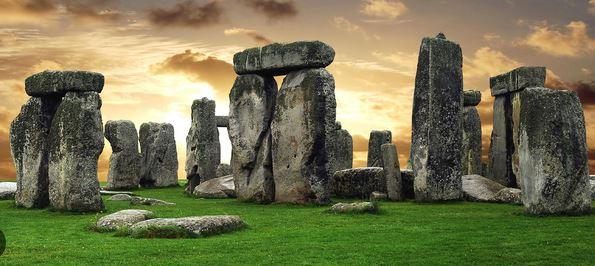The spiritual significance of stone circles is deeply rooted in their symbolism, their connection to ancient belief systems, and their role in rituals and ceremonies. These ancient stone structures represent not just physical landmarks, but also profound spiritual concepts related to life, death, nature, and the cosmos. Below, I'll dive deeper into the various spiritual meanings attributed to stone circles.
1. Cosmic and Cyclical Symbols
At the core of many stone circles is the symbolism of the circle itself, representing eternity, the universe, and the cyclic nature of existence. The circle is one of the oldest symbols in human history, often interpreted as a metaphor for the wholeness of existence and the continuous cycles of life, death, and rebirth.
-
Eternal Cycle: Stone circles are often seen as representations of the endless cycles of life—birth, growth, death, and rebirth. This could reflect not only seasonal changes but also the broader cycle of the soul, with death leading to renewal and transformation.
-
The Cosmos: The arrangement of stones, often aligned with celestial events like the solstices, reflects an understanding of the universe as ordered and divinely inspired. In this sense, the stone circle symbolizes the microcosm (the individual) mirroring the macrocosm (the cosmos). Humans, in this belief system, are seen as part of a larger cosmic design.
2. Connection to the Divine and the Elements
Many ancient cultures believed that stone circles had a sacred connection to the divine forces that governed nature. The stones were thought to serve as gateways or connections between the earth and the heavens. Each stone might have represented a divine energy, and the circle itself was a way of honoring and communicating with the natural world and the spiritual realm.
-
Earth and Sky: Stones in circles may have symbolized the earth, while the alignment of the circle with celestial bodies—the sun, moon, stars—could represent the divine forces of the heavens. This connection between earth and sky often embodied a sacred union, with the stone circle serving as a place of worship or ritual to honor the spiritual forces at work in the universe.
-
The Elements: Stone circles are often linked to the classical four elements—earth, air, fire, and water. The stones themselves are of the earth, the alignment with the sun and stars brings fire and air into the picture, and water could be incorporated in rituals, such as using water in libations or creating offerings. These elements together form a holistic view of the world, in which the spiritual and physical realms are interconnected.
3. Solar and Lunar Significance
The solstices and equinoxes are of major spiritual significance in many cultures, and stone circles are often aligned with these celestial events. These events mark transitions in the seasonal cycle, which are deeply connected to life and spiritual renewal.
-
Sun Worship: In many traditions, the sun is worshipped as a symbol of life, growth, and illumination. Stone circles that align with the sun's movement—especially during the summer and winter solstices—may have been designed to mark these important moments in the agricultural year when the sun’s power is most evident.
-
Lunar Significance: In addition to the sun, the moon often played a key role in the spiritual lives of ancient peoples. Moon cycles were used to track time and seasons, and in many cultures, the moon was associated with feminine energy, intuition, and the mysteries of life. Some stone circles are thought to have been used to track lunar cycles, helping early societies understand the rhythm of time and the seasons.
4. Ritual and Ceremony
Stone circles were likely places of ritual and ceremonial practice, serving as sacred spaces where people connected with the divine, made offerings, and celebrated the changing seasons. These rituals could include prayers, sacrifices, dances, and meditations, all meant to honor the natural world and seek blessings from the divine.
-
Seasonal Festivals: Many cultures celebrated the equinoxes and solstices, which marked key transitions in the agricultural calendar. The stone circle could have served as a gathering place for these important festivals, celebrating the abundance of the earth, asking for good harvests, and honoring the forces of nature.
-
Sacred Spaces: In some cultures, stone circles were used as places of initiation or spiritual awakening, where individuals underwent rituals to mark their transition into adulthood, maturity, or a new spiritual stage. These rituals could have included meditation, prayer, and other sacred rites to invoke divine protection and wisdom.
5. Spiritual Healing and Energy
Stone circles are sometimes thought to be places of healing or places where the spiritual energy of the earth is concentrated. Stones themselves have been viewed as healing objects in many cultures, believed to possess special properties that could purify the soul, enhance spiritual growth, and protect individuals.
-
Ley Lines and Earth Energy: In some esoteric traditions, stone circles are associated with ley lines, which are thought to be lines of energy that run through the earth. These lines are believed to be places of spiritual power, and stone circles, by virtue of their placement on these lines, are thought to have amplified the spiritual energy of the land.
-
Healing Circles: Some modern spiritual practitioners visit ancient stone circles for healing ceremonies or to meditate in these sacred spaces to connect with their higher self or receive guidance from the spirit world. Many modern beliefs hold that stone circles are places where the earth's energy and cosmic energies converge, making them perfect locations for spiritual cleansing and rejuvenation.
6. Connection to the Ancestors
Stone circles often hold deep ancestral significance. In many ancient cultures, stone circles were seen as places where the living could communicate with the dead. The stones might be viewed as memorials or markers of the ancestors' presence, creating a sense of continuity between the generations.
-
Ancestor Worship: Some cultures believe that the stones themselves contain the spirits of the ancestors, and ceremonies performed at these sites were a way of honoring their memory and seeking their blessings. In this sense, stone circles are not just symbols of spiritual practices but also serve as tangible connections to the past.
-
Rites of Passage: Stone circles might have been places where individuals could honor their ancestors during key life events, such as births, deaths, and marriages. These rituals could involve invoking the wisdom of ancestors to guide and protect the living.
7. Sacred Geometry
The shape and alignment of the stones in a stone circle may also have been chosen for their geometric and mathematical properties. Ancient cultures were often deeply attuned to sacred geometry, the study of geometric shapes and patterns believed to have spiritual significance.
-
Sacred Proportions: Many stone circles exhibit geometric precision, with stones arranged in specific patterns that follow sacred geometrical ratios, such as the golden ratio or Pi. These proportions were thought to reflect universal truths and to help align individuals with the spiritual forces of the cosmos.
-
Harmonizing Energy: The careful arrangement of stones in perfect alignment may also have been intended to create a space where cosmic energies could be harmonized. The circle, in its perfect shape, may symbolize the order and harmony of the universe, aligning the human spirit with the forces of nature and the divine.
Conclusion
The spiritual significance of stone circles is rich and multifaceted. They serve as powerful symbols of cosmic order, the cyclical nature of life, and the interconnection between the human spirit and the natural world. Whether used for astronomical observation, ritual practice, healing, or ancestor worship, these ancient sites continue to be powerful reminders of humanity’s quest for spiritual understanding and connection to the divine.


